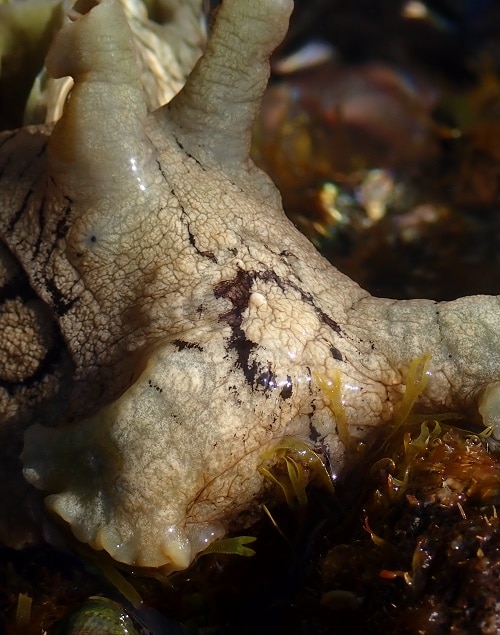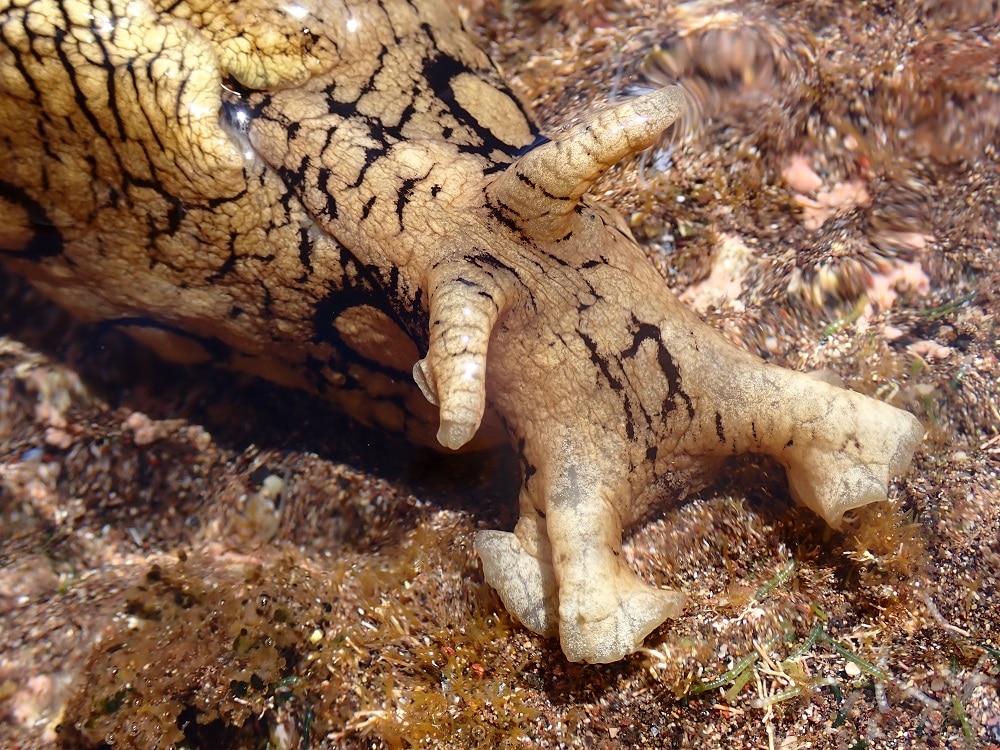I had never seen a sea hare until recently despite living on the coast, and boy, was it a surprise when I came across my first one! It was Aplysia dactylomela, the spotted sea hare. This marine bug looks like a sea slug but huge, growing to a maximum size of up to 40 cm/15″ in rare cases. The species is easy to spot while snorkeling, as it prefers the shallows, where it feeds on algae.
If you spotted one on one of your snorkel or scuba trips and want to know more, keep reading as we dive into the wacky world of the spotted sea hare!
Spotted sea hare appearance
As mentioned, this is a pretty wacky marine bug to come across if you haven’t seen it before. The spotted sea hare (Aplysia dactylomela) is a gastropod from the family Aplysiidae, which forms part of the larger order Opisthobranchia. They usually grow to around 20 cm (8″), although larger specimens have been recorded. This makes them quite a bit bigger than most other sea slugs!
Aplysia dactylomela can be told apart from other sea hares by the black rings on its body, which can vary in base color from greyish-yellow to dark brown. On top of the body, also known as the mantle, are ruffled folds called the parapodia.
The spotted sea hare does have an internal shell, but it’s quite fragile and doesn’t appear to serve much of a purpose. Some experts have suggested it’s an evolutionary remnant and that opisthobranchs like this one previously had more pronounced shells.
| Name (common, scientific) | Spotted sea hare, Aplysia dactylomela |
| Family | Aplysiidae |
| Spread | Atlantic Ocean |
| Habitat | Shallow waters and tide pools |
Planning your next snorkel trip?
Spotted sea hare habitat
This gastropod was long considered a pan-tropical species, meaning a creature that naturally occurs in pretty much all the tropical regions in the world. In 2013, though, it was discovered that the specimens found in the Indo-Pacific Oceans are actually a different species: Aplysia argus. Despite being very visually similar, they’re not genetically the same.
The discovery of the genetic distinction between Aplysia dactylomela and argus means that the former is actually mostly an Atlantic inhabitant.
This being said, like many other sea creatures (such as the bearded fireworm), the spotted sea hare is also a newcomer in the Mediterranean. From the early 2000s onwards, it has been busy colonizing this new territory. Its sudden appearance is probably a result of increasing sea temperatures.
In their natural habitats, spotted sea hares are mostly found in the shallows, where plenty of (macro)algae are present. They’re common in tide pools and coastal zones.

Spotted sea hare facts
Diet
The spotted sea hare is the cow of the sea; the species is a herbivore that naturally feeds on algae. It’s not fussy, usually consuming a wide range of what’s available. This includes different kinds of sea lettuce from genera like Ulva and Enteromorpha.
As discussed below, the consumption of red marine algae like Hypnea musciformis can give these ophistobranches an extra edge when it comes to defense against predators.
Defense mechanisms
Yep! Despite being a peaceful herbivore, the spotted sea hare is not actually defenseless. Its large, soft body may look like a tasty treat to some predators, but Aplysia has a surprise up its sleeve. Like an octopus, it can squirt a purplish ink to deter attackers. This ink is produced as a result of the consumption of red pigments from certain seaweeds.
Research has suggested this ink has several functions, and some predators, like seagulls, do indeed avoid it. It likely works not just as a kind of smoke screen, but may also taste bad and is possibly an irritant.
Reproduction
Like many other (sea) slugs, Aplysia dactylomela is a hermaphrodite, making it both male and female. When spotted sea hares meet to mate, one of them will take on the role of sperm depositor and the other takes care of the egg – except in some cases, when they just do both at once. They’re known to sometimes form long chains of individuals mating at the same time.
After fertilization, the sea hares go their separate ways to lay their eggs. Upon hatching, the baby slugs pass through a planktonic phase where they’re extremely tiny and eat phytoplankton (tiny planktonic particles). After around 30 days, they metamorphose into small but fully developed sea hares.
Did you know? Aplysia dactylomela only lives for a little under a year, but can produce dozens of millions of eggs during this time. They start mating when they’re only two months old and don’t stop until they eventually perish.
Yep, it can swim!
Although it’s probably the last thing you’d expect from a sea slug, the spotted sea hare can swim. If you see one on the seafloor, it’s easy to wonder why it appears to have a sort of crack down the middle – well, those are its parapodia, which it can move up and down to propel itself through the water. They’re surprisingly graceful!
Studies have shown that the most likely reason for sea hares to swim is food. They would also swim if attacked, but not quite as often as for foraging purposes.
Research
Interestingly, the spotted sea hare is an extremely extensively researched creature. Scientists are interested in things like its ink, but what they’re mostly after is the brain. This species is a prime candidate for neurological research because of its giant right neuron, which is located in the abdominal ganglion.
Basically, this neuron is not dissimilar to that of larger creatures, meaning it can be used to easily and reliably study all sorts of brain functions, like reflexes.
If you have any more questions about the spotted sea hare or want to share a story of one of your own encounters with the invertebrate cow of the sea, don’t hesitate to leave a comment below!

